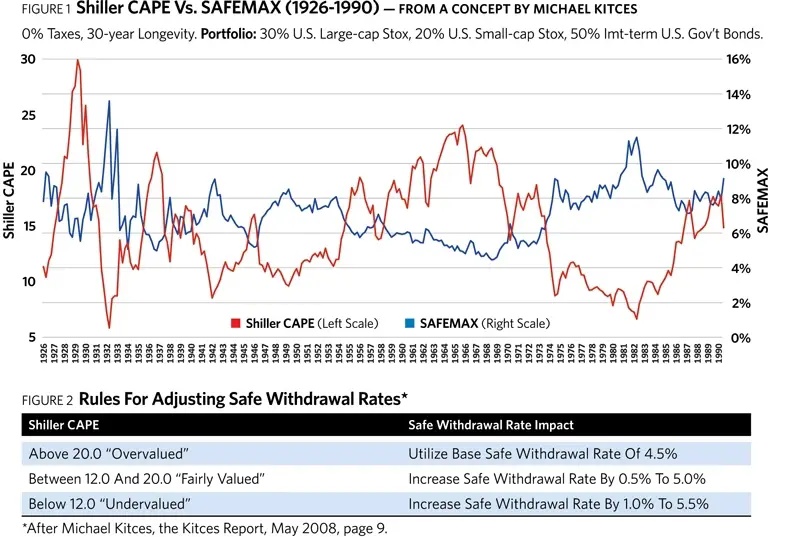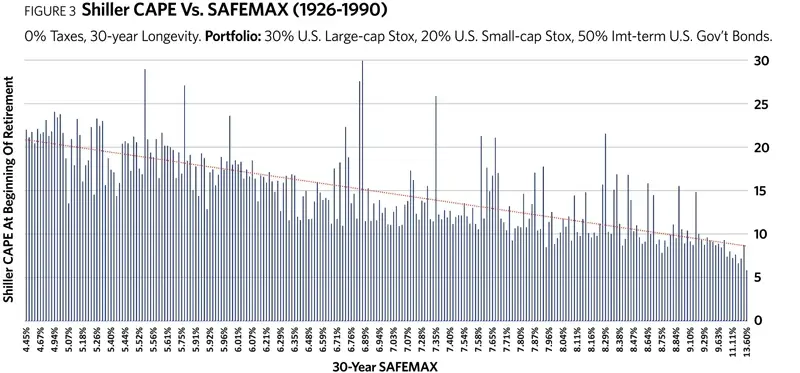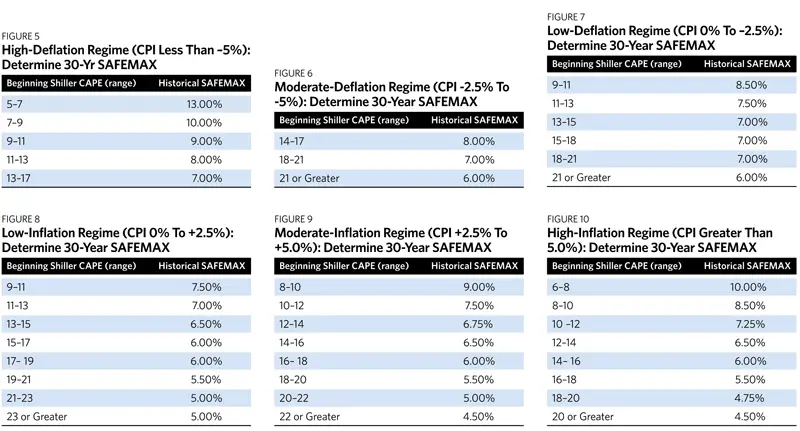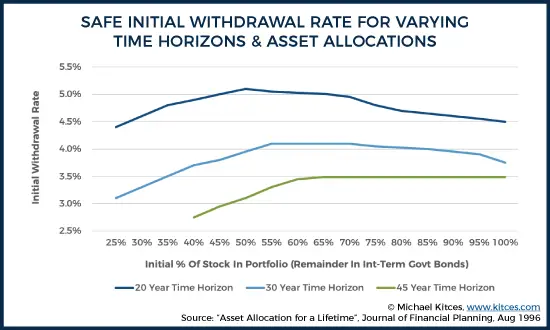Financially reviewed by Patrick Flood, CFA.
With high stock valuations and low bond yields, is the “4 percent rule” for retirement withdrawal rate still valid for the 21st-century investor? Let's dive in.
Disclosure: Some of the links on this page are referral links. At no additional cost to you, if you choose to make a purchase or sign up for a service after clicking through those links, I may receive a small commission. This allows me to continue producing high-quality content on this site and pays for the occasional cup of coffee. I have first-hand experience with every product or service I recommend, and I recommend them because I genuinely believe they are useful, not because of the commission I may get. Read more here.
Contents
What Is the 4% Rule?
The 4% rule refers to what is widely accepted as a safe withdrawal rate (SWR) for retirees from their investment account. Using this figure and assumptions about future expenses and investment returns, young investors can estimate how much they need to save and invest to retire and the age at which they can retire.
But where does the 4% rule come from?
Financial planner William Bengen wanted to establish a retirement withdrawal rate he could tell his clients so that they wouldn't outlive their savings after retiring. Previously, advisors had used vague rules of thumb for retirement withdrawal rates without any strong underlying math. Bengen sought something more rigorous and robust to use with his own clients. Prior to becoming a CFP, Bengen was literally a rocket scientist, so he was well-suited for the task, and set out to do it himself.
In 1994, through his research of modeling hypothetical retirements starting in 51 years between 1926 and 1976 and using real historical returns, he observed that 4% was the withdrawal rate at which no failures occurred when simulating possible outcomes for minimum-30-year periods. Thus, 4% was the maximum number that was deemed “safe.” His landmark paper appeared in the Journal of Financial Planning. You can find his book on Amazon here.
A subsequent study from Cooley et al in 1998 now known as the Trinity Study backed up Bengen's findings, though for some reason they used corporate bonds instead of treasury bonds, which strikes me as odd.
Implications of the 4 Percent Rule as a Retirement Withdrawal Rate
Specifically, the “4 percent rule” means that at retirement, the retiree can withdraw 4% of the portfolio the first year, followed by the same amount, adjusted for inflation, every year thereafter for 30 years without exhausting the portfolio. Another way of saying this in planning terms is that you can multiply your estimated annual expenses in retirement by 25 to estimate how much you need to save for retirement, colloquially called the “25x rule.” I'm of the mind that this is actually the most useful application of the 4% rule as opposed to a rigid dictation of annual withdrawal amounts in retirement. More on this later.
“4% rule” is perhaps a misnomer. Bengen never intended for his finding to be dubbed a “rule.” He was simply interested in seeing empirically what a safe withdrawal rate was historically for a 30-year retirement. Period. The circulation of his findings was so widespread that it is now called “the 4% rule.”
Some may also assume that means you have to use 4% in your math. This isn't true. It is more of a general suggestion that provides a framework for financial planning for what was historically the worst-case scenario. There may indeed be a “worst case” in the future worse than the one Bengen observed that affects your retirement.
All things being equal, decreasing the withdrawal rate is a safer assumption, and increasing the rate is a more aggressive assumption. But all crystal balls are cloudy. Bengen purposefully spanned all economic conditions over 51 years, during which some simulated portfolios had higher safe withdrawal rates. The point is 4% was the maximum for any of them. In other words, it was the worst case scenario, which may very well occur in the future.
At retirement, you are likely no longer making contributions and are instead withdrawing money each year. So inflation hurts, and returns matter. Since withdrawals don’t get replenished by new contributions (your human capital is now exhausted), the sequence of your returns also matters. Withdrawals hurt the future portfolio value more in bear markets and less during bull markets, as you are withdrawing proportionally more during the former and proportionally less during the latter. The combination of withdrawing and poor portfolio performance may deplete the portfolio so much that you later exhaust the retirement savings that are left.
Markets are largely unpredictable. The expected annualized return of your investment portfolio is not going to happen every single year. The long-term averaging out or “self correcting” of the stock market doesn’t help over a short period like 5 to 10 years, during which sequence of return risk may ruin the rest of your retirement. In short, if you get a “bad sequence” of returns at the beginning of your retirement, you may run out of money later, and your planned safe withdrawal rate is no longer safe.
On the flip side, you could get a “good” sequence where your safe withdrawal rate is 10%. Since we can't know the future, the type of sequence you get is unfortunately simply a matter of luck. The best recent examples of getting the bad luck of a “bad sequence” would be someone entering retirement in 2000 at the height of the Dotcom Bubble or in 2008 at the start of the Global Financial Crisis.
Still, the famous “4% rule” as a safe withdrawal rate for retirement planning was built based on these risks. My separate post on sequence risk illustrates just how conservative the 4% rule is under “normal” circumstances.
Is the 4% Rule Still Valid as a Safe Withdrawal Rate?
The 4% rule has come under fire recently, with many questioning its validity for the future given the current investment landscape with high stock valuations, low bond yields, and fears of inflation and rising interest rates. In other words, some think the historical safe withdrawal rate of 4% may no longer be “safe.”
The most common criticism nowadays of the 4 percent rule goes something like this: Bengen's calculation relied on historical stock and bond returns (about 10% and 5% respectively) and these assumptions may no longer work going forward if we see low stock returns and rising interest rates.
This is a fundamental misunderstanding of how the 4% SWR was established. The observation does not rely on the historical average returns of stocks and bonds. If we expected the market to deliver this average return, the SWR would be about 7%. Rather, Bengen looked at 30-year retirements beginning in 50 different years, meaning some had very bad starting sequences of returns as described above. These are the outliers that resulted in the 4% SWR observation. Basically, again, 4% is what worked in the worst case scenarios.
In that sense, the 4% rule already covers low-return environments, because it was built from them.
Intuitively, this should make sense (but if it doesn't, there are some graphs on this page). Starting conditions are far more impactful for the SWR than the average market returns over the retirement timeline. But this also doesn't mean we should altogether ignore future expected returns. More on this later.
Bengen also used a static, relatively conservative asset allocation and asset selection in his analyses. Specifically, he used 50% large cap stocks and 50% intermediate treasury bonds, which again averaged about 10% and 5% returns respectively. The historical performance of this portfolio was drastically different than, say, 60% large cap stocks, 20% small cap stocks, and 20% long term bonds. More on this in a second too.
Moreover, Bengen only used U.S. assets. This makes the 4 percent rule look unrealistically rosy. I'm a fan of global diversification. Historically, as Bengen showed, the SWR for U.S. assets was 4%. But the historical SWR for a global portfolio was 3.5%, as retirement researcher Wade Pfau showed in his 2017 book titled How Much Can I Spend in Retirement?. This does not mean you should have a portfolio of entirely U.S. stocks. I've gone into great detail elsewhere about why that's a silly idea. We would also expect international diversification in equities to help mitigate sequence risk, which again should be of greater concern to the retiree than absolute returns per se.
While we can't know the future, we can speak generally about the expected returns of stocks and bonds. Valuation metrics for the stock market (e.g. Shiller CAPE) are near record highs, and interest rates and subsequent bond yields are extremely low. While I'm not one to jump on the fearmongering bandwagon about hyperinflation and rising rates, we can fairly reliably say that we should expect lower returns for both of these asset classes in the future relative to what we've seen historically, if for no other reason than the simple fact that investment capital is growing faster than the investments available. But this doesn't mean the 4% rule is dead.
In terms of retirement, high valuations should mean lower initial withdrawal rates. That is, we're now presented with the decision of whether or not to continue with Bengen's 4% SWR into what may be uncharted territory. Then again, the future is by definition uncharted territory.
Retirement researcher Michael Kitces concluded that the Shiller CAPE valuation metric and safe initial withdrawal rates are indeed strongly negatively correlated (specifically, -0.74) but that the 4% rule should still hold using a 60/40 portfolio. Kitces's graph below (updated by Bengen) is what Bengen calls “the single most important chart ever devised pertaining to ‘sustainable withdrawals'”, in which “SAFEMAX” refers to the maximum safe initial withdrawal rate for a 30-year retirement. Note that the following graphs use Bengen's updated 4.5% SWR after including small cap stocks; I've included a section on it below.

In short, as Bengen says, “it paid to retire when stocks were cheap.” The average safe withdrawal rate from the figure above was 7%, but remember the whole point of determining a withdrawal rate we can call “safe” is to prepare for the worst. On the other hand, we also don't want to leave money on the table and die with millions left unspent from being too safe, which is a criticism of the 4 percent rule. Such is the crux of the unknowability of the future.
But, we do know the present. Kitces proposes a timing overlay where initial withdrawals are based on current market valuations:

But Bengen also points out that Shiller CAPE doesn't give us the full story in terms of predictive power and precision, and there are still significant outliers in the data that don't match expectations (see lines above extending past or not meeting the trendline). The missing piece, he maintains, is inflation. Bengen's latest research specifically investigates its effects on withdrawal rates. Bengen notes:
“I can’t emphasize enough the importance of inflation to a portfolio’s sustainability. The time line of inflation that a retiree experiences when they stop working is as important to their portfolio’s endurance as the sequence of investment returns, which has received much greater attention. This truth has been masked by a history of generally low inflation in the United States over the last 100 years (leaving out the 1970s and the period from 1948 to 1952).”
Remember we're adjusting withdrawals by the CPI every year in retirement. Accelerating inflation means lower purchasing power, which necessitates a higher withdrawal rate. But even considering high valuations and rising inflation, Bengen still found that the 4% rule was safe. Again, I think we should expect this; keep in mind that Bengen's original calculation covered both the Great Depression and the hyperinflation of the 1970's. He actually concluded that 1966 was the worst year to retire historically due to inflation. I've written elsewhere why I think the U.S. can likely avoid hyperinflationary environments like that one altogether going forward after the shift in monetary policy during the Volcker era in the early 1980's.
Bengen built on Kitces's efforts and proposed a new “scheme” for an initial retirement withdrawal protocol that incorporates both inflation and Shiller CAPE to estimate one's initial safe withdrawal rate, specifically using trailing 12-month CPI and current market Shiller CAPE ratio, two figures that are readily available:

Bengen summarizes this scheme as follows:
“In summary, based on the earlier work of Michael Kitces, I have presented a tabular method to select an initial withdrawal rate for retirement portfolios, based on both recent inflation and stock market valuations. It exhibits a wide range of choices, between the “worst case” of 4.5% and a high of 13%, representing the full range of historically successful withdrawal rates. It is simple to use, though right now it applies only to tax-advantaged portfolios with a desired longevity of 30 years. I should also issue the usual cheerful disclaimer that this research is based on the analysis of historical data, and its application to future situations involves risk, as the future may differ significantly from the past. The term ‘safe' is meaningful only in its historical context, and does not imply a guarantee of future applicability.”
Bengen sort of glosses over that “longevity of 30 years” piece. Another consideration in all this is lifespan. People are living longer. Bengen's research has used a retirement timeline of 30 years of withdrawals. What if you need to go longer than that? As we extend that timeline, the safe withdrawal rate drops. This is particularly applicable with the prevalence of the FIRE movement (more on that later). A decent rule of thumb seems to be dropping the SWR by half a percent for every additional 10 years of retirement, e.g. the 4% rule for 30 years becomes 3.5% for 40 years, 3% for 50 years, etc. Put another way, a 40 year retirement with a 4% withdrawal rate has “only” an 87% success rate.
Recently, retirement researchers Michael Finke, Wade Pfau, and David Blanchett wanted to see how a 4% withdrawal rate behaves if we assume low expected returns for both stocks and bonds for the duration of the retirement. Specifically, they used a -1.4% real return on bonds and a 4.6% real return for stocks. Running Monte Carlo simulations for 30-year retirements using this portfolio, a 4% withdrawal rate failed 57% of the time.
Don't freak out just yet.
First, assuming a -1.4% real return for bonds for the entire retirement seems, in Michael Kitces's words, “unduly harsh.” He notes: “while it’s still notable that the TIPS curve implies that real returns will be about 2% below the long-term historical average, that’s still 2% better than a 30-year real return of -1.4%. Or viewed another way, projecting a -1.4% real return for 30 years still assumes that markets are drastically wrong about long-term real returns, and that long-term TIPS are still poised for a strong rally (which would ultimately be necessary to drive today’s 30-year 0.6% TIPS rate down to a -1.4% real return over 30 years).“
Finke et al addressed this by also projecting -1.4% real bond returns for 5 years and then having them normalize to their historical average of 2.6% for the remainder of the period. This resulted in a 4% withdrawal rate failing a non-trivial 18% of the time.
Secondly, though, recall that the 4% rule was born of worst-case scenarios in history, which included periods of flat or negative real bond returns and below-average real stock returns. The hypothetical portfolio from Finke et al assumes a real return of 2.2% for a 60/40 portfolio for the entire duration of the retirement.
Kitces doesn't draw a hard conclusion on either side of whether the 4 percent rule is still valid for these bad outlooks or whether it should be lowered. He simply raises the considerations and suggests that in any case, “when the retiree is walking near the edge of the cliff, there’s more danger than when the retiree is walking safely inland. But just because you’re living the scenario on the right doesn’t mean you are going off the cliff; just that you need to be more cautious!”
Another brief “pro” worth mentioning for the 4% rule is that the research shows that spending tends to decrease later in retirement, so it's likely that the portfolio would not be drawn down as much as the 4% rule assumes with a constant withdrawal model.
The 4.5% Rule
Financial research has made leaps and bounds in just the past 30 years since Bengen's original research that yielded the 4% rule. For example, we now know we should reliably expect small cap value stocks to outperform large cap growth stocks over the long term.
Given this, Bengen's newest model, which you may have noticed in the graphs above, uses a portfolio of:
- 30% U.S. large cap stocks
- 20% U.S. small cap stocks
- 50% U.S. intermediate treasury bonds
The addition of small cap stocks improved the safe withdrawal rate from 4% to 4.5%. Interestingly, while it wouldn't make much sense behaviorally, a portfolio of 100% small cap value stocks has exhibited the highest safe withdrawal rate historically.
To be clear, this updated 4.5% SWR only applies if the investor is overweighting small cap stocks relative to their market weight. Many investors, like those holding Vanguard's VT or VTI, or a target date fund in their 401k, will not be doing this. For the sake of clarity, I'll be referring to the “traditional” 4% rule below in the rest of this post when I mention its derivations. I'll try to make this clear at each mention, but there are a lot of numbers being tossed around.
The implication here is that strategic asset allocation, diversification, flexible spending, having an emergency fund, and optimization for expected returns where possible should be considered significant, useful tactics in maximizing the likelihood of the portfolio's survival through retirement. My own portfolio is well-diversified and optimized for expected returns for these reasons.
The 4% Rule and FIRE (Financial Independence, Retire Early)
The FIRE movement (Financial Independence, Retire Early) have adopted the 4% rule as a core tenet, because it allows them to estimate the dollar number they'll need to retire early (the RE part). Remember, to do that using the 4% rule, one can just multiply their estimated annual expenses in retirement by 25.
But the “E” piece specifically presents a not-so-straightforward challenge for the FIRE folks. It should appear obvious that, as indicated above, as we extend the retirement period, the SWR must necessarily drop. This is because as the time period increases, so too does the number of consistent annual withdrawals from the portfolio that do not get replenished, and the portfolio must survive longer. Longer retirements also amplify sequence risk, for better or for worse.
More specifically, the retiree will also necessarily be withdrawing during bear markets at some points, which hurts the portfolio's future value much more than withdrawing during bull markets. The popular FIRE blogger Mr. Money Mustache seems to forget that fact; I categorically disagree with his strange assertion here that “above 30 years, the length of your retirement barely affects the safe withdrawal rate calculations.” Even just glancing at some of the figures in Bengen's original research tells us this isn't the case. Bengen himself has explicitly said “the withdrawal rate is sensitive to the time horizon; the longer you plan to live, the lower it goes.”
In my experience, instances of a 4% SWR being thrown around in the context of FIRE discussions seem to take the 4 percent rule at face value and completely ignore the aforementioned specifics I've mentioned here in regards to inflation, sequence risk, and lower future expected returns. I can't really blame them; the term “the 4% rule” sounds like you can use it reliably without any further digging. Again, sort of a misnomer.
It's not all bad news, though; remember that sequence risk can also have an upside. It's just that we have to prepare for the downside. Hope for the best but prepare for the worst. The risks of choosing a retirement withdrawal rate estimate are asymmetrical. The consequences of outliving your retirement savings are far greater than those of accidentally saving too much. These points illustrate the importance of always having an emergency fund so that you don't have to tap the portfolio for expenses during severe market downturns.
I noted above that a decent rule of thumb is to drop the withdrawal rate by half a percent for every additional 10 years of retirement. That is, if one plans to use a 4% SWR when retiring at 60, they might want to use 3.5% if retiring 10 years earlier at 50. Bengen himself showed in his follow-up paper in 1996 that a 45-year retirement had a SWR of 3.5%. Here's that illustration adapted by Kitces:

Bengen's original research found that at a 3% withdrawal rate, all portfolios survived for 50 years. After his new 4.5% SWR with the inclusion of small cap stocks, that 3% figure becomes 3.5%.
In fairness, though, the FIRE movement does seem to suggest adopting some sort of “side hustle” – ideally something you enjoy – for some extra income after you retire. Bengen's 4% SWR assumes that the retiree will never add another dollar to the portfolio. Investing some extra money during retirement definitely gets you further away from the edge of Kitces's aforementioned cliff.
While they may not seem like much at first glance, the benefits of a variable spending strategy and additional income during retirement to the survivability of the portfolio for the FIRE retiree cannot be overstated. It should be obvious that the same fixed percentage withdrawal – regardless of what that specific percentage is – should not happen for both a year when your portfolio is up 25% and a year that your portfolio is down 25%.
Also note that Bengen's research used tax-advantaged accounts. Early retirees may face greater tax implications on portfolio gains. Bengen's follow-up paper in 1996 illustrates that for a 35% tax rate, the SWR basically drops by half a percent, e.g. 4% becomes 3.5%.
In short:
- Be aware of the fact that most of the popular “FIRE calculators” out there use a 4% withdrawal rate for the underlying math.
- Establish a rules-based variable spending strategy for retirement.
- Try to get some additional income flowing after you retire.
Keep your fingers crossed for some Social Security income in the U.S., but I wouldn't count on it in your planning.
So, will 4% work for FIRE? Maybe. But 3.5% is inarguably a safer estimate, and is likely a more realistic number given current stock valuations and future expected returns. Given the research from Bengen, Finke, Pfau, and Kitces, my background in math, my risk-averse nature, a variable spending plan, and future expected returns of my globally diversified portfolio of stocks and bonds that heavily tilts small cap value, if I wanted to end up FIRE-ing soon and had to pick a number, I'd use a 3.5% withdrawal rate estimate for planning (specifically, telling me the number at which I could FIRE). This is basically taking Bengen's new 4.5% SWR and subtracting half a percent for lower future expected returns and another half a percent for a retirement period longer than the 30 years he observed.
However, recall those beautiful tables above from Bengen's most recent research that take current valuations and inflation into account in the first year of retirement. They show us that the starting conditions at retirement are extremely important. I don't employ or condone market timing, but it would be naive not to at least acknowledge the economic environment at retirement given the wide distribution of outcomes it creates in the historical data. Incorporating those metrics likely yields a more statistically reliable withdrawal rate and may help us avoid leaving millions in the portfolio at death (the result of positive sequence risk), rather than taking a shot in the dark by arbitrarily choosing a SWR estimate irrespective of the market environment. This protocol at least gives us somewhat of a starting point, but then remember we still want to titrate down to compensate for a longer retirement period.
Here's a tangible real-world example of that.
At the time of writing, trailing 12-month CPI (Consumer Price Index; measure of inflation) was 1.7%, and the Shiller CAPE ratio of the S&P 500 is about 37, which is extremely high relative to history. Given these numbers, Bengen's tables tell us that the historical max SWR for that starting environment was 5% for a 30-year retirement. Let's assume the person FIRE-ing today is planning instead for a 50-year retirement. Dropping half a percent for every 10 additional years yields a SWR estimate of 4%.
I think Bengen's tables (his “scheme,” as he calls it) give us a little more reliability and precision, because they show that the worst case scenario (retiring in the late 1960's), which the 4% rule was built upon, was an environment of simultaneous high inflation and high stock valuations.
You may have noticed a glaring problem with this approach, though: We can't know the economic environment at the beginning of our retirement ahead of time. This sort of obviates it for planning purposes in terms of calculating how much we need to save.
For example, an investor using a 5% SWR estimate with estimated annual expenses of $50,000 knows they need to save $1 million to retire. But let's say they enter retirement with a last-year CPI of 1% and a Shiller CAPE of 12, meaning a low inflation regime and relatively low stock market valuations. Bengen's tables give us a SWR of 7% for this scenario. Hypothetically, were the investor able to know this ahead of time, they would have known they only needed to save about $714,000 for retirement, meaning they could have retired much earlier. On the plus side, this just means they'll likely be able to safely spend more in retirement with their $1 million.
Now let's look at the opposite scenario. Suppose that same investor who saved $1 million based on a 5% SWR estimate enters retirement with a CPI of 3% and a Shiller CAPE of 25, a moderate inflation regime with high valuations. Bengen's tables tell us the SWR is 4.5% for that scenario, meaning the investor may want to delay their retirement until they can save that additional $111,111 or try to cut spending in the early years of their retirement so that they can hopefully live off $45,000/year instead of the estimated $50,000, all while hoping that inflation and valuations both decrease.
So while it may indeed be a useful exercise when entering retirement, Bengen's tables probably don't help us all that much in trying to calculate how much to save decades ahead of time. This circles us back to our shot-in-the-dark estimate of a safe withdrawal rate. In my opinion, all roads point to 3.5% for FIRE, and that's only if you're overweighting small cap value stocks. If you're using market cap weights or a target date fund, this becomes 3%.
Conclusion
The famous “4 percent rule” refers to the maximum safe withdrawal rate observed by financial advisor and retirement researcher William Bengen for a 30-year retirement with a U.S. portfolio of 50% large cap stocks and 50% intermediate treasury bonds.
Bengen recently added in small cap stocks and found the 4% SWR becomes 4.5%. He then investigated the effects of stock valuations and inflation on safe withdrawal rates and proposed a timing scheme by which retirees can hopefully withdraw with more predictive precision. However, this timing strategy doesn't really help us in our planning decades ahead of time since we can't know the future.
Keep in mind that the 4% rule (or the 4.5% rule, or any X% rule) is a backward-looking observation that is meant to be used as a guideline. It is only a rule of thumb. It makes no promises or guarantees about the future. Allow it to provide a framework for expectations, but remain flexible, particularly in regards to spending in retirement.
Longer lifespans and early retirements (e.g. FIRE) invariably lower the safe withdrawal rate. In these contexts, I'd be more likely to use an estimate of 3.5%.
Once again, strategic asset allocation, diversification, flexible spending, having an emergency fund, and optimization for expected returns where possible should be considered important and impactful tactics in maximizing the likelihood of the portfolio's survival through retirement. My own portfolio is well-diversified and optimized for expected returns for these reasons.
What are your thoughts on the 4% rule? Let me know in the comments.
Are you nearing or in retirement? Use my link here to get a free holistic financial plan and to take advantage of 25% exclusive savings on financial planning and wealth management services from fiduciary advisors at Retirable to manage your savings, spend smarter, and navigate key decisions.
Disclaimer: While I love diving into investing-related data and playing around with backtests, this is not financial advice, investing advice, or tax advice. The information on this website is for informational, educational, and entertainment purposes only. Investment products discussed (ETFs, mutual funds, etc.) are for illustrative purposes only. It is not a research report. It is not a recommendation to buy, sell, or otherwise transact in any of the products mentioned. I always attempt to ensure the accuracy of information presented but that accuracy cannot be guaranteed. Do your own due diligence. I mention M1 Finance a lot around here. M1 does not provide investment advice, and this is not an offer or solicitation of an offer, or advice to buy or sell any security, and you are encouraged to consult your personal investment, legal, and tax advisors. Hypothetical examples used, such as historical backtests, do not reflect any specific investments, are for illustrative purposes only, and should not be considered an offer to buy or sell any products. All investing involves risk, including the risk of losing the money you invest. Past performance does not guarantee future results. Opinions are my own and do not represent those of other parties mentioned. Read my lengthier disclaimer here.

Are you nearing or in retirement? Use my link here to get a free holistic financial plan and to take advantage of 25% exclusive savings on financial planning and wealth management services from fiduciary advisors at Retirable to manage your savings, spend smarter, and navigate key decisions.





New video from Ben Felix suggesting the new safe withdraw rate is closer to 2.7% https://www.youtube.com/watch?v=1FwgCRIS0Wg&ab_channel=BenFelix
Yea, saw it a while back.
Could we say that in a Country such as Brazil where historically we have high real interest rates, with a 50%/50% portfolio, the safe withdraw rate could be higher?
Hi John. Once again thanks for your articles.
I leave on a high inflation country (Brazil), and even high real interest rates (big banks love here). I see this scenario as positive for higher SWR, if you are locked on long term GOV bonds that pays a fixed + inflation.
So what are your thoughts on that?
Thanks
I do like the idea of including inflation-linked bonds at retirement, if that’s what you mean.
I have FIREd in January 2021 at the age of 47.5 and am assuming a SWR of 2.7%. At current valuations, anything more than that is quite dangerous in my view. Fyi, I have spent all my career in Global Markets with large banks, index firms and some in retirement planning. The key fact is that at current valuations a 0% return on equities for at least 10 years is a safe assumption. Plus over a 50 year retirement a lot of force majeur including wars and conflict will certainly happen.
Market prices are good indications of an asset’s value. Annuties for standard retirement (at 65) deliver only about 1.7%. Factoring in a huge 1% as profit margin, one still gets to only 2.7% and thats for an estimated 20-30 yr retirement. What are your thoughts on annuity pricing ?
Fantastic article !
Was wondering if having a sizable allocation towards inflation adjusted annuities would account for longevity risk in early retirement, and hypothetically if that risk is somewhat mitigated would it allow a more aggressive allocation with the remaining capital towards say a 60/40 of VBR/VGLT ? Additionally, since the 4% rule assumes a US only allocation, could it benefit from international diversification for reliability ?
Thanks !
Thanks, Matthew!
Admittedly I don’t have much knowledge about or experience with annuities but it’s a topic I want to read up on more.
I’m always a fan of international diversification, but since the U.S. has outperformed foreign stocks historically, the historical SWR was actually lower for international stocks. Things may look different going forward.